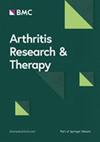皮肤增厚的消退是否预示着弥漫性皮肤系统性硬化症患者内脏受累情况的改善和生存期的延长?EUSTAR 分析
IF 4.9
2区 医学
Q1 Medicine
引用次数: 0
摘要
弥漫性皮肤系统性硬化症(dcSSc)患者的皮肤纤维化经常出现自发性改善。我们的目的是研究皮肤纤维化的改善是否预示着内脏器官恶化的可能性降低和生存率提高。研究对象包括欧洲硬皮病试验与研究(EUSTAR)队列中的 dcSSc 患者,这些患者的基线改良罗德南皮肤评分(mRSS)≥7 分,且在 12±3 个月的随访中 mRSS 评分有效。皮肤纤维化的消退/进展定义为从基线到随访期间mRSS下降/上升>5分且≥25%。随访结果包括肺、肾、心脏和胃肠道表现的进展(根据共识得出的定义)以及全因死亡。通过单变量、Kaplan-Meier 生存曲线和 Cox 回归分析,比较了退缩、稳定和进展患者的情况。在纳入的 1257 名患者中,883 人(70.2%)病情稳定,282 人(22.4%)病情退步,92 人(7.3%)病情进展。与进展期患者相比,根据基线 mRSS、基线免疫抑制、基线 FVC 和病程进行调整后,进展期患者的 FVC 下降≥10% 的概率显著低于进展期患者(P=0.00003),随访期间全因死亡的概率也显著低于进展期患者(P=0.035)。.皮肤纤维化的改善与其他器官表现的进展无关。我们发现,皮肤纤维化的消退与较低的肺部进展概率和较好的随访生存率有关。SSc患者皮肤纤维化和肺纤维化病程之间的联系有助于在临床实践中更好地对患者进行分层,并在临床试验中为ILD进展期患者提供丰富的治疗方案。- 皮肤纤维化得到改善的弥漫性 SSc 患者的肺功能进展和全因死亡率均低于皮肤进展期患者。- 这有助于在临床实践中更好地对 SSc 患者进行风险分层。- 这有助于改进SSc临床试验的设计,更好地丰富ILD进展期患者。本文章由计算机程序翻译,如有差异,请以英文原文为准。
Does regression of skin thickening predict improvement of internal organ involvement and survival in patients with diffuse cutaneous systemic sclerosis? A EUSTAR analysis
Patients with diffuse cutaneous systemic sclerosis (dcSSc) frequently show spontaneous improvement of skin fibrosis. Our aim was to examine whether an improvement in skin fibrosis predicts lower likelihood of visceral organ progression and better survival. Patients from the European Scleroderma Trials and Research (EUSTAR) cohort with dcSSc, baseline modified Rodnan skin score (mRSS) ≥7, and valid mRSS at 12±3 months follow up were included. Regression/progression of skin fibrosis was defined as a decrease/increase in mRSS >5 points and
≥25% from baseline to follow up. The outcomes included progression of lung, renal, cardiac and gastrointestinal manifestations using consensus derived definitions and all-cause death. Regressive, stable and progressive patients were compared by univariate, Kaplan-Meier survival curve and Cox regression analysis. Of 1257 included patients, 883 (70.2%) were stable, 282 (22.4%) regressive, and 92 (7.3%) progressive. Regressive patients, adjusted for baseline mRSS, baseline immunosuppression, baseline FVC, and disease duration, showed a significantly lower probability of FVC decline ≥10% than progressive patients (p=0.00003), lower probability of all-cause mortality during follow up (p=0.035) compared to progressive patients. .Improvement of skin fibrosis was not associated with progression of other organ manifestations. We found that regression of skin fibrosis is associated with a lower probability of lung progression and better survival at follow up. The link between the disease course of skin and lung fibrosis in SSc can help to better stratify patients in clinical practice and enrich for ILD progressive patients in clinical trials. • Diffuse SSc patients with improvement of skin fibrosis had a lower probability of lung function progression and all-cause mortality than skin progressive patients. • This allows better risk stratification of SSc patients in clinical practice. • It could help to improve the design of clinical trials in SSc and better enrichment of ILD progressive patients.
求助全文
通过发布文献求助,成功后即可免费获取论文全文。
去求助
来源期刊

Arthritis Research & Therapy
RHEUMATOLOGY-
CiteScore
8.60
自引率
2.00%
发文量
261
审稿时长
14 weeks
期刊介绍:
Established in 1999, Arthritis Research and Therapy is an international, open access, peer-reviewed journal, publishing original articles in the area of musculoskeletal research and therapy as well as, reviews, commentaries and reports. A major focus of the journal is on the immunologic processes leading to inflammation, damage and repair as they relate to autoimmune rheumatic and musculoskeletal conditions, and which inform the translation of this knowledge into advances in clinical care. Original basic, translational and clinical research is considered for publication along with results of early and late phase therapeutic trials, especially as they pertain to the underpinning science that informs clinical observations in interventional studies.
 求助内容:
求助内容: 应助结果提醒方式:
应助结果提醒方式:


